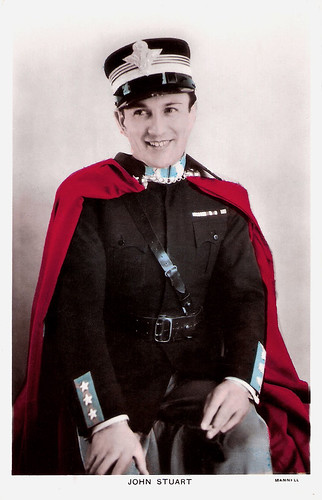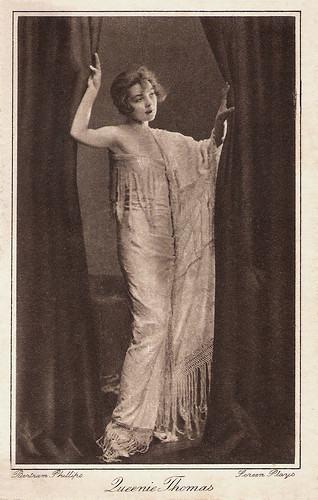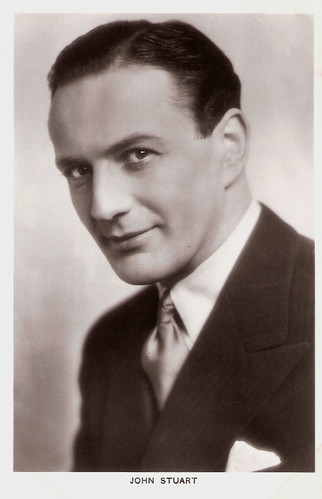We're still in Italy and enjoy Il Cinema Ritrovato (21 June-29 June 2025). In the section One Hundred Years Ago: 1925, Alfred Hitchcock's debut film will be showcased in the programme. The sensational The Pleasure Garden (1925) tells the story of two chorus girls at the Pleasure Garden Theatre in London and their troubled relationships. Glamorous American star Virginia Valli played the lead. The male star was the Scottish actor John Stuart (1898-1979), a very popular leading man in British silent films in the 1920s.

British postcard in the Colourgraph Series, London, no. C. 237. Photo: Mannell.

British postcard in the Picturegoer Series, London, no. 54b.

British postcard in the Picturegoer Series, London, no. 54e.
John Stuart was born John Alfred Louden Croall in Edinburgh, Scotland in 1898. He began his stage and screen career directly after World War I service in 'The Black Watch'. He made his film debut in the drama The Lights of Home (Fred Paul, 1920).
Other silent films were the drama If Four Walls Told (Fred Paul, 1922) starring Lillian Hall-Davis, the comedy The School for Scandal (Bertram Phillips, 1923) with Queenie Thomas, and the comedy We Women (W.P. Kellino, 1925).
Stuart was a very popular leading man in British silent films, though it's hard to gauge that popularity since many of his best films of the 1920s, such as A Sporting Double (Arthur Rooke, 1923), Constant Hot Water (George A. Cooper, 1924) and The Tower of London (Maurice Elvey, 1926) with Isobel Elsom, are either inaccessible or non-existent.
He appeared in a silent film directed by Alfred Hitchcock. The Pleasure Garden (1925) was Hitchcock’s directorial debut. Based on a novel by Oliver Sandys, the film is about two chorus girls at the Pleasure Garden Theatre in London and their troubled relationships. Glamorous American star Virginia Valli played the lead. The film was shot in Italy and Germany in 1925 and shown to the British press in March 1926. But it was not officially released in the UK until 1927, after Hitchcock's film The Lodger: A Story of the London Fog became a massive hit in February 1927.
Stuart worked several times with director Maurice Elvey. Very popular was their World War I drama Mademoiselle from Armentieres (Maurice Elvey, 1926), featuring Estelle Brody. The film opened in London in September 1926 and was still playing in cinemas around the country until well into 1927. It was reportedly the most profitable British film of 1926 and made an instant star of Brody. The two stars were reunited in the drama Hindle Wakes (Maurice Elvey, 1927), which skilful use of location is considered to give the film a documentary realism feel very unusual in British films of the period. Brody and Stuart co-starred again in Mademoiselle Parley Voo (Maurice Elvey, 1928), a sequel to Mademoiselle from Armentieres, and equally successful. Both films refer to the popular First World War song Mademoiselle from Armentières.

Lillian Hall-Davis German postcard by Ross Verlag, Berlin, no. 1479/2, 1927-1928. Photo: Ufa.

Queenie Thomas. British postcard in the series Screen Plays. Photo: Bertram Phillips.

Virginia Valli. British postcard. The frame is similar to those of Beagles and Lilywhite. The name is scratched away but this could be a photo by Autrey.
John Stuart’s first sound film, Kitty (Victor Saville, 1929) was another successful production. Kitty was initially planned and filmed as a silent, but on its original completion director Saville decided to reshoot the latter part with sound. As no suitable facilities were yet available in Britain, Saville, Estelle Brody and Stuart travelled to New York to shoot the new sequences at RKO Studios. The film was released in the form of a silent which switched to sound after the halfway point.
Stuart’s next film, Atlantic (1929) was one of the first British films made with the soundtrack optically recorded on the film (sound-on-film). Atlantic was directed and produced by Ewald André Dupont. Three versions were made, an English and a German language version, Atlantik, which were shot simultaneously, and later a French version was made. In England, Atlantic was released in both sound and silent prints. The film was originally made as Titanic but after lawsuits it was renamed Atlantic. The White Star Line, which owned the RMS Titanic, was still in operation at the time. The final scene of the film was filmed as a shot of the liner sinking but it was cut at the last minute as it was feared it would upset Titanic survivors.
Then Stuart worked for a second time with Alfred Hitchcock, although indirectly. Elstree Calling (1930) is a lavish musical film revue directed by Andre Charlot, Jack Hulbert, Paul Murray, and Hitchcock at Elstree Studios. It was Britain's answer to the Hollywood revues, such as Paramount on Parade (Dorothy Arzner et al, 1930) and The Hollywood Review of 1929 (Charles Reisner, 1929). Stuart was not appearing in the segments directed by Hitchcock.
They really worked together again on Number Seventeen (Alfred Hitchcock, 1932), in which Stuart played the lead. The film is about a group of criminals who committed a jewel robbery and put their money in an old house over a railway leading to the English Channel, the film's title being derived from the house's street number. An outsider stumbles onto this plot and intervenes with the help of a neighbour, a police officer's daughter. On its initial release, audiences reacted to Number Seventeen with confusion and disappointment.
Stuart then played Sir Henry Baskerville in the mystery The Hound of the Baskervilles (Gareth Gundrey, 1932), based on the novel by Arthur Conan Doyle and scripted by Edgar Wallace. He was the co-star of Brigitte Helm in The Mistress of Atlantis (Georg Wilhelm Pabst, 1932), the English language version of the German-French adventure and fantasy film L'Atlantide / Die Herrin von Atlantis (Georg Wilhelm Pabst, 1932) based on the novel 'L'Atlantide' by Pierre Benoît.

British postcard in the Picturegoer Series, London, no. 54. Photo: Mills.

British postcard in the Picturegoer Series, London, no. 54c.

British postcard in the Picturegoer Series, London, no. 54e.
John Stuart starred with Benita Hume in the drama Men of Steel (George King, 1932). It was made at Nettlefold Studios under the so-called Quota Quickie system for distribution by United Artists. In 1927, The Cinematograph Films Act was designed to stimulate the declining British film industry. It introduced a requirement for British cinemas to show a quota of British films, for 10 years. The result of the act was the 'quota quickie', a low-cost, poor-quality film commissioned by American distributors operating in the UK purely to satisfy the quota requirements.
During the 1930s Stuart appeared in a lot of these films. Memorable are the drama The Lost Chord (Maurice Elvey, 1933) with Elizabeth Allan and Jack Hawkins, the comedy This Week of Grace Chord (Maurice Elvey, 1933) starring Gracie Fields and Henry Kendall, and Anglo-Italian aviation drama The Blue Squadron (George King, 1934) with Esmond Knight.
Stuart co-starred with Fritz Kortner and Nils Asther in Abdul the Damned (Karl Grune, 1935), set in the Ottoman Empire in the years before the First World War where the Sultan and the Young Turks battle for power. He also worked often with director George Pearson, like in the thriller The Secret Voice (1936), and appeared in several parts of the long-running Old Mother Riley series. During the war years, Stuart’s parts became smaller or better said, he matured into character parts.
He played a supporting part in the thriller Headline (John Harlow, 1944) with David Farrar as a crime reporter who searches for a mystery woman (Anne Crawford) who has witnessed a murder. Another example is the Gainsborough melodrama Madonna of the Seven Moons (Arthur Crabtree, 1945) starring Phyllis Calvert, Stewart Granger and Patricia Roc. In 1946 readers of the Daily Mail voted the film their third most popular British movie from 1939 to 1945. During the following decades, he played government officials and police inspectors in B-films like the mystery The Ringer (Guy Hamilton, 1952) starring Herbert Lom, and the Science Fiction film Four Sided Triangle (Terence Fisher, 1953).
Memorable are the war film Sink the Bismarck! (Lewis Gilbert, 1960) with Kenneth More, the Science Fiction film Village of the Damned (Wolf Rilla, 1960), and the suspense film Paranoiac (Freddie Francis, 1963) from Hammer Films starring Janette Scott and Oliver Reed. Stuart only played bit roles in these films. His last part was a cameo in Superman (Richard Donner, 1978). In 1979, John Stuart died in London at the age of 81. He is buried in Brompton Cemetery, London. An accomplished writer, John Stuart penned his autobiography, 'Caught in the Act', in 1971. His son, author and journalist Jonathan Croall published 'Forgotten Stars: My Father and the British Silent Film World' (2013) a book about the English screen idols of the 1920s.

British postcard in the Film Weekly Series, London, no. 2.
Trailer The Pleasure Garden (1925). Source: BFI films (YouTube).
Sources: Hal Erickson (AllMovie - Page now defunct), Wikipedia and IMDb.

British postcard in the Colourgraph Series, London, no. C. 237. Photo: Mannell.

British postcard in the Picturegoer Series, London, no. 54b.

British postcard in the Picturegoer Series, London, no. 54e.
Instant star
John Stuart was born John Alfred Louden Croall in Edinburgh, Scotland in 1898. He began his stage and screen career directly after World War I service in 'The Black Watch'. He made his film debut in the drama The Lights of Home (Fred Paul, 1920).
Other silent films were the drama If Four Walls Told (Fred Paul, 1922) starring Lillian Hall-Davis, the comedy The School for Scandal (Bertram Phillips, 1923) with Queenie Thomas, and the comedy We Women (W.P. Kellino, 1925).
Stuart was a very popular leading man in British silent films, though it's hard to gauge that popularity since many of his best films of the 1920s, such as A Sporting Double (Arthur Rooke, 1923), Constant Hot Water (George A. Cooper, 1924) and The Tower of London (Maurice Elvey, 1926) with Isobel Elsom, are either inaccessible or non-existent.
He appeared in a silent film directed by Alfred Hitchcock. The Pleasure Garden (1925) was Hitchcock’s directorial debut. Based on a novel by Oliver Sandys, the film is about two chorus girls at the Pleasure Garden Theatre in London and their troubled relationships. Glamorous American star Virginia Valli played the lead. The film was shot in Italy and Germany in 1925 and shown to the British press in March 1926. But it was not officially released in the UK until 1927, after Hitchcock's film The Lodger: A Story of the London Fog became a massive hit in February 1927.
Stuart worked several times with director Maurice Elvey. Very popular was their World War I drama Mademoiselle from Armentieres (Maurice Elvey, 1926), featuring Estelle Brody. The film opened in London in September 1926 and was still playing in cinemas around the country until well into 1927. It was reportedly the most profitable British film of 1926 and made an instant star of Brody. The two stars were reunited in the drama Hindle Wakes (Maurice Elvey, 1927), which skilful use of location is considered to give the film a documentary realism feel very unusual in British films of the period. Brody and Stuart co-starred again in Mademoiselle Parley Voo (Maurice Elvey, 1928), a sequel to Mademoiselle from Armentieres, and equally successful. Both films refer to the popular First World War song Mademoiselle from Armentières.

Lillian Hall-Davis German postcard by Ross Verlag, Berlin, no. 1479/2, 1927-1928. Photo: Ufa.

Queenie Thomas. British postcard in the series Screen Plays. Photo: Bertram Phillips.

Virginia Valli. British postcard. The frame is similar to those of Beagles and Lilywhite. The name is scratched away but this could be a photo by Autrey.
Number seventeen
John Stuart’s first sound film, Kitty (Victor Saville, 1929) was another successful production. Kitty was initially planned and filmed as a silent, but on its original completion director Saville decided to reshoot the latter part with sound. As no suitable facilities were yet available in Britain, Saville, Estelle Brody and Stuart travelled to New York to shoot the new sequences at RKO Studios. The film was released in the form of a silent which switched to sound after the halfway point.
Stuart’s next film, Atlantic (1929) was one of the first British films made with the soundtrack optically recorded on the film (sound-on-film). Atlantic was directed and produced by Ewald André Dupont. Three versions were made, an English and a German language version, Atlantik, which were shot simultaneously, and later a French version was made. In England, Atlantic was released in both sound and silent prints. The film was originally made as Titanic but after lawsuits it was renamed Atlantic. The White Star Line, which owned the RMS Titanic, was still in operation at the time. The final scene of the film was filmed as a shot of the liner sinking but it was cut at the last minute as it was feared it would upset Titanic survivors.
Then Stuart worked for a second time with Alfred Hitchcock, although indirectly. Elstree Calling (1930) is a lavish musical film revue directed by Andre Charlot, Jack Hulbert, Paul Murray, and Hitchcock at Elstree Studios. It was Britain's answer to the Hollywood revues, such as Paramount on Parade (Dorothy Arzner et al, 1930) and The Hollywood Review of 1929 (Charles Reisner, 1929). Stuart was not appearing in the segments directed by Hitchcock.
They really worked together again on Number Seventeen (Alfred Hitchcock, 1932), in which Stuart played the lead. The film is about a group of criminals who committed a jewel robbery and put their money in an old house over a railway leading to the English Channel, the film's title being derived from the house's street number. An outsider stumbles onto this plot and intervenes with the help of a neighbour, a police officer's daughter. On its initial release, audiences reacted to Number Seventeen with confusion and disappointment.
Stuart then played Sir Henry Baskerville in the mystery The Hound of the Baskervilles (Gareth Gundrey, 1932), based on the novel by Arthur Conan Doyle and scripted by Edgar Wallace. He was the co-star of Brigitte Helm in The Mistress of Atlantis (Georg Wilhelm Pabst, 1932), the English language version of the German-French adventure and fantasy film L'Atlantide / Die Herrin von Atlantis (Georg Wilhelm Pabst, 1932) based on the novel 'L'Atlantide' by Pierre Benoît.

British postcard in the Picturegoer Series, London, no. 54. Photo: Mills.

British postcard in the Picturegoer Series, London, no. 54c.

British postcard in the Picturegoer Series, London, no. 54e.
Quota quickie
John Stuart starred with Benita Hume in the drama Men of Steel (George King, 1932). It was made at Nettlefold Studios under the so-called Quota Quickie system for distribution by United Artists. In 1927, The Cinematograph Films Act was designed to stimulate the declining British film industry. It introduced a requirement for British cinemas to show a quota of British films, for 10 years. The result of the act was the 'quota quickie', a low-cost, poor-quality film commissioned by American distributors operating in the UK purely to satisfy the quota requirements.
During the 1930s Stuart appeared in a lot of these films. Memorable are the drama The Lost Chord (Maurice Elvey, 1933) with Elizabeth Allan and Jack Hawkins, the comedy This Week of Grace Chord (Maurice Elvey, 1933) starring Gracie Fields and Henry Kendall, and Anglo-Italian aviation drama The Blue Squadron (George King, 1934) with Esmond Knight.
Stuart co-starred with Fritz Kortner and Nils Asther in Abdul the Damned (Karl Grune, 1935), set in the Ottoman Empire in the years before the First World War where the Sultan and the Young Turks battle for power. He also worked often with director George Pearson, like in the thriller The Secret Voice (1936), and appeared in several parts of the long-running Old Mother Riley series. During the war years, Stuart’s parts became smaller or better said, he matured into character parts.
He played a supporting part in the thriller Headline (John Harlow, 1944) with David Farrar as a crime reporter who searches for a mystery woman (Anne Crawford) who has witnessed a murder. Another example is the Gainsborough melodrama Madonna of the Seven Moons (Arthur Crabtree, 1945) starring Phyllis Calvert, Stewart Granger and Patricia Roc. In 1946 readers of the Daily Mail voted the film their third most popular British movie from 1939 to 1945. During the following decades, he played government officials and police inspectors in B-films like the mystery The Ringer (Guy Hamilton, 1952) starring Herbert Lom, and the Science Fiction film Four Sided Triangle (Terence Fisher, 1953).
Memorable are the war film Sink the Bismarck! (Lewis Gilbert, 1960) with Kenneth More, the Science Fiction film Village of the Damned (Wolf Rilla, 1960), and the suspense film Paranoiac (Freddie Francis, 1963) from Hammer Films starring Janette Scott and Oliver Reed. Stuart only played bit roles in these films. His last part was a cameo in Superman (Richard Donner, 1978). In 1979, John Stuart died in London at the age of 81. He is buried in Brompton Cemetery, London. An accomplished writer, John Stuart penned his autobiography, 'Caught in the Act', in 1971. His son, author and journalist Jonathan Croall published 'Forgotten Stars: My Father and the British Silent Film World' (2013) a book about the English screen idols of the 1920s.

British postcard in the Film Weekly Series, London, no. 2.
Trailer The Pleasure Garden (1925). Source: BFI films (YouTube).
Sources: Hal Erickson (AllMovie - Page now defunct), Wikipedia and IMDb.
No comments:
Post a Comment